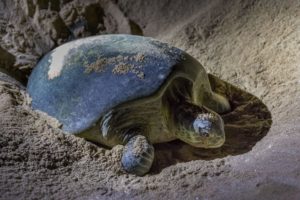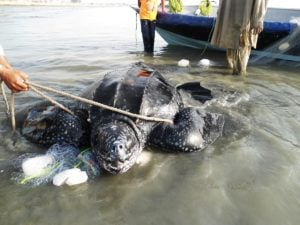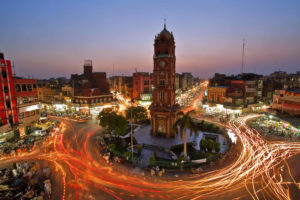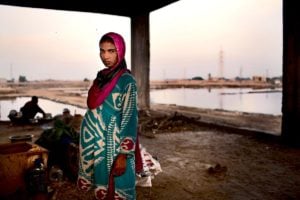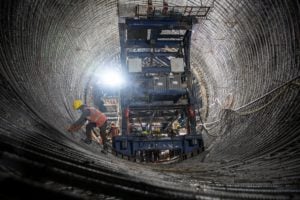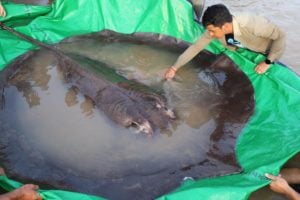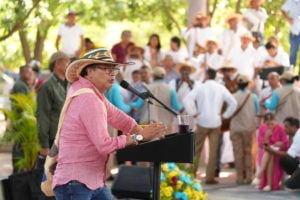As Pakistan celebrated independence day on 14 August 2023, the chief minister of Sindh province inaugurated the 5.9 kilometre Mauripur road. Funded by the World Bank, the road rehabilitation is part of the PKR 840 million (USD 3 million) Competitive and Livable City of Karachi (CLICK) project for Karachi.
Just 15 days later, turtle hatching season began in the Hawkesbay and Sandspit beaches, about 100 metres from the newly inaugurated road. What no one seemed to have factored in was how the 500 120-watt LED streetlights along the length of the road would affect marine wildlife – particularly nesting turtles.
Shoaib Abdul Razzaq, the Marine Programme Coordinator at the World Wide Fund in Pakistan told The Third Pole that the gentle slopes and sandy textures of these beaches were ideal for turtle nesting sites. However, the harsh white LED lights could act as a significant disruptor.
A 2022 research paper on the impacts of Artificial Light at Night (ALAN) on marine ecosystems in the Indo-Pacific Ocean wildlife highlighted that light pollution (the excessive use of outdoor artificial light) is a particularly significant threat for nesting and hatchling turtles. Artificial light interferes with the navigation capabilities of female turtles as they choose their nesting sites, and also affects hatchlings as they make their way to the beach and out to the sea.
Razzaq said that, after sunset, female turtles remain submerged waiting for the high tide to give them a push to cover some distance of the beach. During this time, they also scan for threats, and if “human activities or lights are spotted, there are chances they return to sea without egg laying, or revisit when there are no threats for them.”
Umair Bin Zamir, a Geographic Information System expert and a marine turtle researcher explained that both turtle hatchlings and adult turtles are naturally drawn toward the horizon’s natural light. If the natural light is disrupted by excessive artificial light, it can interfere with their natural path.
The turtle hatching season in Karachi is from September to mid-February, according to the head of the Sindh Wildlife Department’s Marine Turtle Conservation Ashfaq Ali Memon. He said that during this season (September 2023 – February 2024), 275 of the 650 female turtles that visited the beach returned to the sea without laying eggs. Last year (September 2022 to February 2023), 500 female turtles visited the beach, and 250 went back without laying eggs. Female turtles return to the sea without laying eggs due to many factors, including unwanted human interference, beach development, marine debris, plastics, the presence of predators like stray dogs, and the impact of light pollution.
The proportion of turtles returning without laying eggs actually fell after the installation of the bright lights on Mauripur road, therefore just one year on from the installation, it is too early to draw conclusions from the data.
But an investigation into how these lights were installed without a legitimate environmental assessment revealed more about the local administration’s disregard of the hatchery.
Turtle sanctuary ‘missed’ during project design
On 19 December 2023, policy research organisation The Citizenry, emailed Abedalraz F Khalil, the World Bank’s Urban Development, Resilience, and Land Practice Manager for the South Asia Region, flagging concerns raised around light pollution on the marine ecosystems through the project they were funding. The World Bank conducted a site visit the same month.
The CLICK’s environmental safeguard specialist, Zaheer Ahmed, told The Third Pole that various solutions for light pollution were discussed regarding the Mauripur road with the World Bank team. These included shielding the lights with cellophane to change the white light to red, dimming the intense white lights, or keeping every alternative light on, rather than all of them, during the hatching season.
He said CLICK has asked the Sindh Wildlife Department for recommendations, after which it will make a final call.
These issues were not raised during the project design stage. According to WB guidelines, the Karachi Metropolitan Corporation (KMC) which is the executing agency, submitted an Environmental and Social Management Plan for the road rehabilitation. But the plan made no mention of the turtle marine conservation site managed by the Sindh provincial government. While it noted that, “the project area is surrounded by nearby beaches, [and] turtles are also a common sight,” it also explicitly stated, that, “There are no recorded wildlife sanctuaries or game reserves located near the sub-project area”.
The World Bank’s task team lead for CLICK, Tahir Akbar, wrote to The Citizenry on 18 January 2024 saying that when the “CLICK project was prepared impacts on natural habitat were not envisaged.” That is why the World Bank’s “Operational Policy 4.04 Critical Habitats” was not triggered.
On 18 March 2024, Akbar confirmed to The Third Pole that the World Bank was not moving forward with the second phase of the road, “considering our policies related to the preservation of the natural habitats.”
A week later, he wrote that the World Bank had asked KMC, via CLICK’s communication’s liaison, to change the lights to amber “rather than just covering them with a shield as the shields can weather away and there would be less appetite in the local government to fix it.”
Commercial lights
For Memon, whose team of eight protects turtle eggs and hatchlings along 8 kilometres of the coast, the threat from light pollution persists. Memon said that the wildlife department has notified all the beach huts to switch off lights after sunset, especially during the turtle hatching season.
However, at night, especially during the hatchling season at Hawkesbay beach, several beach houses remain not only lit but also have picnickers approaching turtle hatchlings using torches and searchlights.
Late-night parties casting blue, yellow, and white lights directly onto the seashore during the critical turtle hatchling season are common.
On Hawkesbay beach, the Dua Restaurant run with the permission of KMC, casts bright white and yellow lights directly onto the beach where marine turtles lay eggs.
Muhammad Amir, a game watcher from the Sindh Wildlife Department, said that despite their efforts to persuade picnickers to switch off their hut lights, they often refuse to comply. He said that while the local fishing community recognises the importance of protecting marine turtles, educated city dwellers are less responsive to these efforts.
This is an updated article on a longer report on light pollution in Pakistan, published by The Citizenry, and produced with support from Internews’ Earth Journalism Network.
